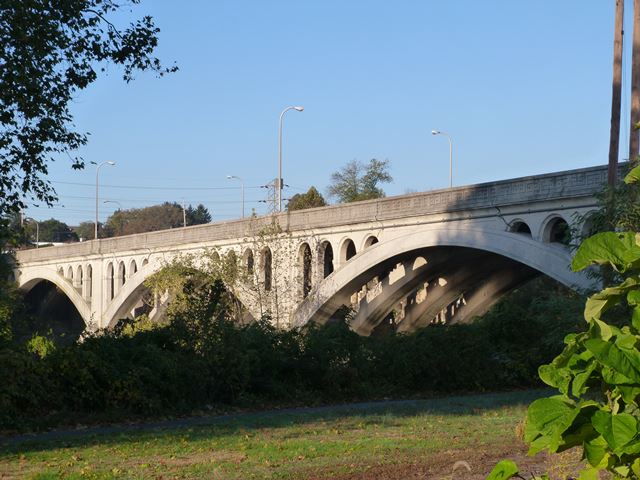We Recommend:
Bach Steel - Experts at historic truss bridge restoration.
BridgeHunter.com Phase 1 is released to the public! - Visit Now
Buttonwood Street Bridge

Primary Photographer(s): Nathan Holth
Bridge Documented: October 20, 2013
Buttonwood Street Over Schuylkill River, US-422, Railroad, and River Road
Reading: Berks County, Pennsylvania: United States
Concrete Open Spandrel Deck Arch, Fixed and Approach Spans: Concrete Rigid-Frame, Fixed
1932 By Builder/Contractor: John H. Wickersham and Engineer/Design: Concrete-Steel Engineering Company of New York, New York
1972
123.0 Feet (37.5 Meters)
770.0 Feet (234.7 Meters)
40 Feet (12.19 Meters)
3 Main Span(s) and 6 Approach Span(s)
6730100009171

View Information About HSR Ratings
Bridge Documentation
View Archived National Bridge Inventory Report - Has Additional Details and Evaluation
View A ZIP Archive of Materials Relating To The Rehabilitation of this Bridge
This bridge consists of a series of approach spans that lead to three concrete arch main spans. This bridge is a unique structure thanks to its elaborate and unusual architectural detailing. It has extensive architectural detailing on the piers, the arches, and the railing is a unique ornamental design. The bridge's aesthetics lead to some unusual structural details as well. The fascia columns on the arch spans are large and elaborate, but in the interior much smaller and less ornamented cylindrical columns are found. The bridge has a companion railroad overpass bridge with similar aesthetic details.
The consulting engineer for this bridge was William Mueser who worked for the Concrete-Steel Engineering Company of New York, New York. Julius Franke was the consulting architect for the bridge. The fact that an architect was hired for this bridge is likely responsible for the unusually elaborate architectural details found on this bridge.
This bridge is slated for rehabilitation.
Information and Findings From Pennsylvania's Historic Bridge InventoryDiscussion of Bridge The 9-span, 770' long reinforced concrete bridge is composed of 3 ribbed open spandrel arch spans over the river and 3 haunch-shaped T beam approach spans on each side. The well proportioned bridge is the most elaborately detailed of the 4 open spandrel arch bridges in downtown Reading. The Neo-Classical detailing includes the spandrel columns and circular headed struts and the Greek meander on both faces of the parapets. The bridge was built in 1931, and it represents the high aesthetics for which the best examples of the technology are noted. The bridge is historically and technologically significant. Discussion of Surrounding Area The bridge carries a 4 lane city street and sidewalks over a the Schuylkill River, SR 422, and a line of the former Reading RR in northwest Reading. Southeast of the bridge is an area of urban renewal with modern houses, and to the northeast is a factory. The west side of the bridge crosses the railroad and SR 422. The road patterns are post World War II, and the bridge is not located in any potential historic districts. Significance The bridge was built in 1931, and it represents the high aesthetics for which the best examples of the technology are noted. The well-proportioned bridge is the most elaborately detailed of the 4 open spandrel arch bridges in downtown Reading. The bridge is historically and technologically significant (criterion C). It reflects the tenets of the City Beautiful movement, and it is one of 12 open spandrel arch bridges in the county built between 1913 and 1955. The open spandrel reinforced concrete arch, which efficiently combines the compressive ability of concrete with the tensile capacity of steel reinforcing, represents the culmination of early 20th century thinking about the material. Noted for their grace and powerful appearance, the bridge type is an economical and aesthetically pleasing use of material, especially the ribbed arch design that results in an even more efficient use of material. Pennsylvania has an exceptionally rich collection of open spandrel arch bridges, and it has some of the earliest large examples of the technology, executed in both plain concrete (H. H. Quimby's 1906-8 Walnut Lane Bridge at Philadelphia) and reinforced concrete represented by the Delaware Lackawanna and Western Railroad's powerful 1911-15 Tunkannock Creek Viaduct at Nicholson that is part of its Summit Cut-off that both rely on their mass and the good compressive quality of concrete) and culminating with the largest and most impressive of all, the 1930-31 Westinghouse Bridge at Pittsburgh. At 460', it has the greatest clear span length for a reinforced concrete arch in the country. Over 60 opens spandrel arch bridges in date from 1906 through at least the mid 1950s remain in Pennsylvania, and it is the early examples and those of high artistic merit that are significant. The technology did not change significantly through the first half of the century, so that a post World War II example reflects the same engineering principals as those built in the 1900s and 1910s. Bridge Considered Historic By Survey: Yes |
![]()
Photo Galleries and Videos: Buttonwood Street Bridge
Bridge Photo-Documentation
Original / Full Size PhotosA collection of overview and detail photos. This gallery offers photos in the highest available resolution and file size in a touch-friendly popup viewer.
Alternatively, Browse Without Using Viewer
![]()
Bridge Photo-Documentation
Mobile Optimized PhotosA collection of overview and detail photos. This gallery features data-friendly, fast-loading photos in a touch-friendly popup viewer.
Alternatively, Browse Without Using Viewer
![]()
Maps and Links: Buttonwood Street Bridge
Coordinates (Latitude, Longitude):
Search For Additional Bridge Listings:
Bridgehunter.com: View listed bridges within 0.5 miles (0.8 kilometers) of this bridge.
Bridgehunter.com: View listed bridges within 10 miles (16 kilometers) of this bridge.
Additional Maps:
Google Streetview (If Available)
GeoHack (Additional Links and Coordinates)
Apple Maps (Via DuckDuckGo Search)
Apple Maps (Apple devices only)
Android: Open Location In Your Map or GPS App
Flickr Gallery (Find Nearby Photos)
Wikimedia Commons (Find Nearby Photos)
Directions Via Sygic For Android
Directions Via Sygic For iOS and Android Dolphin Browser
USGS National Map (United States Only)
Historical USGS Topo Maps (United States Only)
Historic Aerials (United States Only)
CalTopo Maps (United States Only)


